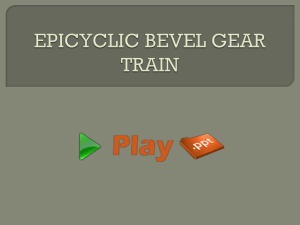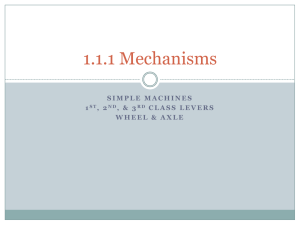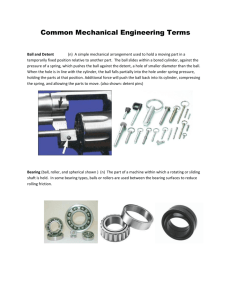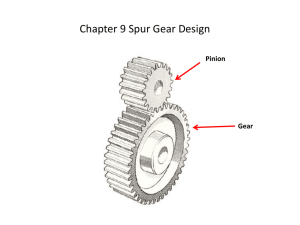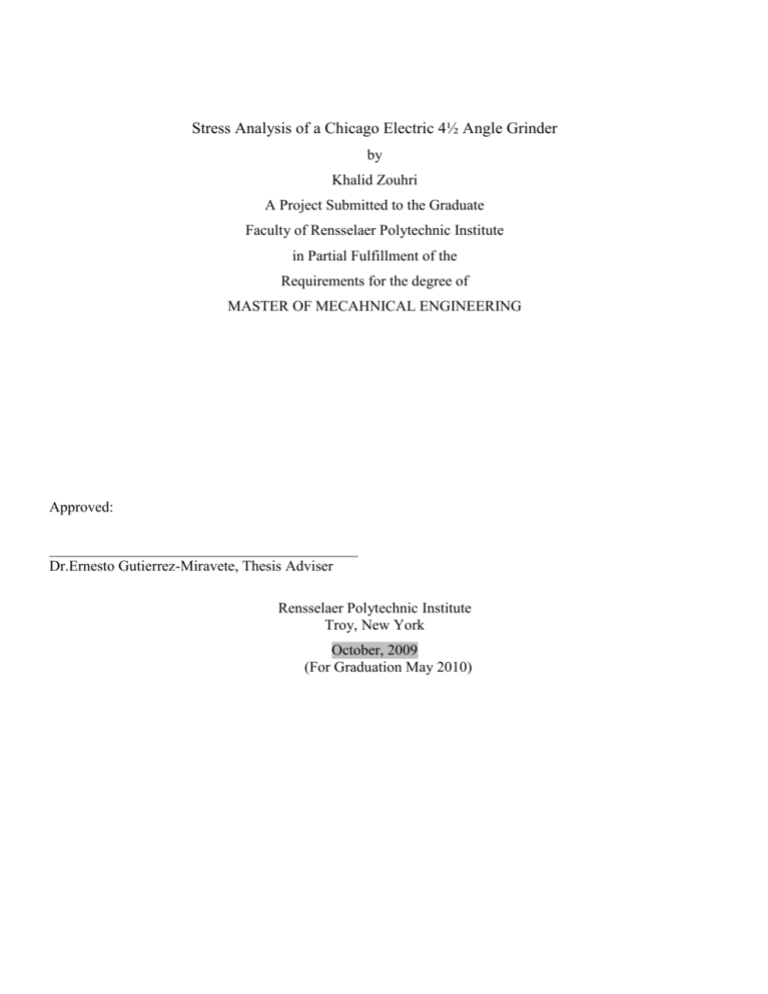
Stress Analysis of a Chicago Electric 4½ Angle Grinder
by
Khalid Zouhri
A Project Submitted to the Graduate
Faculty of Rensselaer Polytechnic Institute
in Partial Fulfillment of the
Requirements for the degree of
MASTER OF MECAHNICAL ENGINEERING
Approved:
_________________________________________
Dr.Ernesto Gutierrez-Miravete, Thesis Adviser
Rensselaer Polytechnic Institute
Troy, New York
October, 2009
(For Graduation May 2010)
© Copyright 2009
by
Khalid Zouhri
All Rights Reserved
Table of Contents
1. Problem Statement ...................................................................................................................... 3
1.1. Photos of the Device, Subassembly, and Components ............................................................ 3
1.2. Given and Measured Data ....................................................................................................... 9
1.1.1. Given Data ............................................................................................................................ 9
1.1.2. Measured Data .................................................................................................................... 10
1.1.3. Schematic Drawing .............................................................................................................. 15
2. Force Analysis ............................................................................................................................ 15
2.1.1. Free Body Diagram of Shaft ................................................................................................ 15
2.1.2. Gear Force Calculations: ...................................................................................................... 16
2.1.3. Shaft Force Calculations: ..................................................................................................... 17
2.1.4. Shear Force and Bending Moment Diagrams ...................................................................... 19
3. Stress Analysis ........................................................................................................................... 20
3.1.1. Bending Stress and Bending Factor of Safety ...................................................................... 20
3.1.2. Wear Stress and Bending Factor of Safety ........................................................................... 22
.
Table of Figures
Figure 1: Chicago Electric Angle Grinder ........................................................................................... 3
Figure 2: Complete Component Assembly .......................................................................................... 4
Figure 3: Bevel Pinion in Gear Casting Subassembly ........................................................................ 4
Figure 4: Bevel Gear in Gear Casing Subassembly ............................................................................ 5
Figure 5: Component Subassembly without Gear Casing .................................................................. 5
Figure 6: Shaft with Bevel Pinion Gear Removed .............................................................................. 6
Figure 7: Shaft with Bevel Pinion Gear .............................................................................................. 6
Figure 8: Bevel Pinion ......................................................................................................................... 7
Figure 9: Components in Position ....................................................................................................... 7
Figure 10: SolidWorks Model Assembly ............................................................................................ 8
Figure 11: SolidWorks Assembly Exploded ....................................................................................... 8
Figure 12: Components Analyzed Exploded...................................................................................... 9
Figure 13: ME-2 Rockwell Hardness Testing System ...................................................................... 10
Figure 14: Hardness Testing for Shaft .............................................................................................. 10
Figure 15: Hardness Testing for Bevel Pinion .................................................................................. 11
Figure 16: Pinion Close-up with Reference Lines ............................................................................ 14
Figure 17: Schematic Drawing .......................................................................................................... 15
Figure 18: Free Body Diagram of Shaft ............................................................................................ 15
Figure 19: Pinion- Bevel Schematic .................................................................................................. 16
Figure 20: Force Analysis 2-D Planes ............................................................................................... 17
Figure 21: Load, Shear Force, and Bending Moment Diagrams ....................................................... 19
Table of Tables
Table 1: Manufacturing Specifications ............................................................................................... 9
Table 3: Hardness Testing Results .................................................................................................... 11
Table 4: Hardness Conversion Chart ................................................................................................ 12
Table 5: AGMA Strength Graph for Gears ...................................................................................... 13
Table 6: Gear and Shaft Information ............................................................................................... 14
1. Objective
The purpose of this Engineering Project for this semester is to do stress analysis of mechanical device Chicago
Electric 4.5 inch angle grinder ITEM 91223-1VGA. The grinder utilizes spiral bevel gears whose output angular
velocity (ω) is 11,000 rpm. The first component I'm going to analyzed it’s the spiral bevel pinion gear (Figure 8).
This pinion gear is directly coupled to the rotor shaft of the electric motor and supplies torque to the
accompanying spiral bevel gear which is closed coupled to the output shaft. The pinion gear is held onto the
end of the rotor shaft by a nut which forces the pinion against one of the two shaft bearings (Figure 7). The
second component I decided to analyze is the rotor shaft of the electric motor (Figure 6).
1.1
Photos of the Device, Sub assembly, and Components
Figure 1: Chicago Electric Angle Grinder
Figure 2: Complete Component Assembly
Figure 3: Bevel Pinion in Gear Casting Sub assembly
Figure 4: Bevel Gear in Gear Casing Subassembly
Figure 5: Component Subassembly without Gear Casing
Figure 6: Shaft with Bevel Pinion Gear Removed
Figure 7: Shaft with Bevel Pinion Gear
Figure 8: Bevel Pinion
Figure 9: Components in Position
1.2 Given Data
In Table 1 below [2], manufacturing specifications are given.
Manufacturing Specifications
Angular Velocity
11,000 rev/min
Horse Power
½ hp
Voltage
110 volts
Frequency (AC)
60 Hz single Phase
Power
570 watts
Amperage
4.5 amps
Table 1: Manufacturing Specifications
1.2 Key Resource
For proper analysis, certain measurable data needed to be collected
The material used in the angle grinder it's unknown we need to do Rockwell Hardness Testing System
Machine to get the data for shaft and bevel gear
Compare the data with hardness conversation chart to get data for the material
Solids Works to do 3D Model
Cosmos to do stress analysis
1.3 Project deadline
project proposal draft posted due 9/25............done
Also, please prepare a brief presentation of your proposed work (6 slides)........Done
First Progress Report due no later than 10/16!
Second Progress Report due no later than 11/6!
Also, please prepare a brief yet comprehensive presentation of progress on your work to date (10 minutes
long; 6-12 slides).
Final Draft due no later than 11/27!
Final Report due no later than 12/11!
Also get prepare a brief yet comprehensive presentation of your work (10 minutes long; 6-12 slides).
Figure 10: SolidWorks Model Assembly
Figure 11: SolidWorks Assembly Exploded
Figure 12 : Components Analyzed Exploded
1.2
1.2.1
Given and Measured Data
Given Data
In Table 1 bellow [2], manufacturing are given.
In Table 1, all specifications are given by the manufacturer except horsepower. Knowing that for single phase
armature motors, one hp is generated by 720 watts. Assuming that the most efficiency expected out of a single phase
motor is approximately 70%, 60% is used in this analysis.
hp
1.2.2
570 w 3
hp
720 w 4
Measured Data
For proper analysis, certain measurable data needed to be collected. The material used in the angle grinder
was unknown; therefore it was necessary to perform hardness testing to gather useful material data. The
shaft and bevel pinion gear were easily accessible by the Rockwell Hardness Testing Machine. This made
the process more reliable in that the integrity of the material was not compromised by forcefully removing
the components from the remaining subassemblies. The bevel gear was completely isolated from its main
subassembly. This ensured no cutting of material or extended surface hardening from clamping and pulling.
The shaft was permanently fixed to its immediate subassembly. Luckily the shaft was just long enough to
get true readings without similar structural compromises as the bevel gear.
Figure 13: ME-2 Rockwell Hardness Testing System
Before the hardness test could begin, proper surface preparation needed to be performed to ensure proper
results. Three readings were done on the shaft as well as the bevel in different locations to and an average
hardness number. The location of testing on the material was also changed to get a variety of readings and to
also not get tainted results from nearby surface hardening created by testing. The hardness testing operation can
be seen below.
It is imperative to note that the material will be much harder on the tooth of the gear rather than in the
makeup material. There was no way to test the hardness of the material directly on the tooth without risking
safety for the holder. The reading, however, was done as close as possible to the side of the tooth without
risking the ball sliding down the face of the tooth.
Table 2: Hardness Testing Result
Using the hardness conversation chart [2] and the information from Shigley’s Mechanical Engineering
Design in Table 5 [3], material grade and tensile strength can be determined .grade1 used for limiting case
material, steel.
Table 3: Hardness Conversion Chart
Figure 4: AGMA Strength Graph for Gears
Tensile Strength Calculation
S t 77.3H b 12,800 psi
S tpiniom 77.3 * 294 12,800 psi 35.526kpsi
S tpiniom 77.3 * 294 12,800 psi 35.526kpsi
Calculations of Diametric Pitch
P
Np
d
Np =13 Teeth
Pt
Np
d
13
d=20.0mm (outside diameter) as shown in figure
teeth / mm 0.65teeth / mm
20
17.
Equation below was used to calculate pitch.
Before the normal diametral pitch can be determined, the helical angle “ψ” needed to be
determined. In the illustration below, lines were added and a protractor was used to measure ψ.
Figure 16: Pinion Close-up with Reference Lines
By using the reference lines the angle ψ was measured to be 40 degree.
To get normal diametral pitch;
Pn
Pn
Pt
cos
0.65
teeth / mm 0.8485teeth / mm
cos 40
Pitch diameter;
dp
N
13teeth
15.32mm
Pn 0.8485teeth / mm
Table 5: Gear and shaft information
1.2.3
Schematic Drawing
Figure 17: Schematic Drawing
2. Force Analysis
1.1. Free Body Diagram of Shaft
Figure 18: Free Body Diagram of Shaft
1.2. Gear Force Calculations:
Figure 19: Pinion- Bevel Schematic
tan 1 (
PinionTeet h
)
Bevelteeth
tan 1 (
PinionTeet h
) 22.1
Bevelteeth
22.1
90 22.1 67.9
t 2 3.25mm cos(22.1 ) 3.011mm
t 3 3.25mm sin( 22.1 ) 1.222mm
These thicknesses represent the location of the pitch point and are illustrated above in Figure 19.
Distance from bearing D to horizontal pitch point location P is:
9.5 mm is from outside of bevel pinion to far side of bearing
Bearing is 7 mm wide so half of bearing is 3.50
DP( x) 19.5 (3.011mm 3.50mm) 13mm
Distance from bearing D to horizontal pitch point location P is:
DP( y )
20 mm
1.222 mm 8.78mm
2
d p 8.78mm 2 17.56mm( pitchdiameter)
t
WBP
t
WBP
60,000 hp
*d *n
3
60,000 hp
4
74 .2 N
*17 .56 mm *11,000 rpm
r
t
WBP
WBP
tan() cos( )
a
t
WBP
WBP
tan() sin( )
r
WBP
74.2N tan 20 cos22.1 25.02N
a
WBP
74.2N tan 20 sin 22.1 10.16N
W 10 .16 i 25 .02 j 74 .2k N
W ABS(W ) 78.96N
1.3. Shaft Force Calculations:
Taking the moment around D:
Figure 20: Force Analysis 2-D Planes
(x-y) plane :
M D Fcy 136 .5mm 10.16 N 8.78mm 25.02 N .13mm 0
Fcy 1.73N (change direction ) 1.73N
Fx W a FDX
0
FDx 10.16N
Fy W r FDy Fcy 0
FDy 26.75N
(x-z ) Plane:
M D W t 13mm Fcz .136 .5mm 0
Fcz 7.07N (change direction ) 7.07N
Fz W t FDZ FCZ 0
FDZ 81.27N
1.73 j 7.07 K N
F
c
FC ABS ( FC ) 7.28 N
F D {10 .16i 26 .75 j 81 .3K}N
FD ABS ( FD ) 86 .2 N
1.4. Shear Force and Bending Moment Diagrams
Figure 21: Load, Shear Force, and Bending Moment Diagrams
23
3. Stress Analysis
Bending Stress and Bending Factor of Safety
Dynamic Factor (Kv)
Assume quality number is 6. Transmission accuracy level number (Qv) could be taken as the
quality number. Qv = 6.
Kv (
A 200 .V B
)
A
A 50 56(1 B) ifB 0.25(12 Qv )
B 0.25 * (12 6)
2
3
2
3
0.8254
A 50 56(1 0.8254) 59.77
*d p *np
V
60
V
*17.56 mm *11,000 rev / min
Kv (
60
10,113 .8 mm sec 10.114 m sec
59 .77 200 10 .114 m / sec .8254
)
1.59
59 .77
Overload Factor (Ko)
Assuming uniform loading, so Ko = 1.
Size Factor Ks.
From Table 14-2 [5], Yp (13T) is 0.261
Face width 6.5 mm →6.5 mm/25.4 mm/in= 0.2559 in.
P = 0.8485 Teeth/mm = 21.552 Teeth/in
Ks
Ks
1
F Y 0.0535
1.192 (
)
This is for standard units
kb
P
1
F Y 0.0535
0.2559 in * 0.261 0.0535
1.192 (
)
1.192 * (
)
0.907
kb
P
21.552 T / in
24
K H Cmf 1 Cmc * (C pf *C pm Cma*Ce )
Assume uncrowned so (load correction factor) Cmc=1
F 10.00
C pf
In (Pinion Proportion factor) Cpf;
F
6.5mm
0.025
0.025 0.0120
10 * d
10 *17.56 mm
Cpm ( pinion proportion modifier)=1.0
Cma(Mesh alignment factor)
Cma A BF CF 2
Using table 14.9 [6] , Value for A,B,C are as follows ( Commercial,Enclosed units);
A=0.127
B=0.0158
C .930 10 4
Cma 0.127 0.0158 0.2559 .930104 *.25592 .1310
Ce( Mesh alignment correction factor )1
K H Cmf 1 1* (0.0120*1 0.1310*1) 1.143
Rim Thickness factor Kb=1 due to consistent thickness of gear.
Speed Ration mG;
mG
N G 32T
2.46
13T
NP
Load Cycle factor (Yn) using 13T for pinion and life cycle 10
25
YN ( P) 1.3558* N p 0.0178 1.3558* (108 ) 0.0178 0.977
From Table 14-10 [7] and a reliability of 0.90, KR (YZ) = 0.85;
From Figure 14-6 [8], The YJ(P) = 0.21
KT (Temperature Factor) Temperature is less than 250 °F so K T = 1
Brinell hardness number 294
St (Allowable Bending Stress for Hardened Steels) for 294 Brinell.
Grade 1:
St (0.533 H B 88.3)MPa (0.533 * 294 * 88.3) 245 MPa
Sc ( Contact fatigue strength ) for brinell and grade 1.
S c (2.22 H B 200 )Mpa (2.22 * 2.94 200 ) 852 .7Mpa
Pinion Tooth bending stress
p W t K0 Kv ks *
P KH KB
*
F
Yj
p 16.7ibf *1*1.59 * .907 *
21.552 T / in 1.143 *1
*
11040 psi 76.1Mpa
0.2559 in
.21
Bending fatigue factor of safety for pinion;
S t * YN
S F ( P)
p KT K R
245 MPA * .977
3.7
S F ( P )
76
.
1
Mpa
*
1
*
.
85
p 76.1MPa
S F ( P) 3.7
26
4. Reference:
[1] Manufacturing Specifications link,
http://www.harborfreight.com/cpi/ctaf/displayitem.taf?Itemnumber=43471
p/english/gear/myset/spiral.html
[2] Hardness conversion chart,
http://www.carbidedepot.com/formulas-hardness.htm
[3] AGMA Strength Graph for Hardened Steels,
Budynas, R., Nisbett, K., Shigley’s Mechanical Engineering Design. 8th Ed. McGraw Hill,
New
York NY, 2008. pp 727
[4] Reliability Assumption,
Budynas, R., Nisbett, K., Shigley’s Mechanical Engineering Design. 8th Ed. McGraw Hill,
New
York NY, 2008. Table 6-5, pp 285
[5] Parameters for Marin Surface Modification Factors,
Budynas, R., Nisbett, K., Shigley’s Mechanical Engineering Design. 8th Ed. McGraw Hill,
New
York NY, 2008. Table 6-2, pp 280
[6] Lewis Form Factor,
Budynas, R., Nisbett, K., Shigley’s Mechanical Engineering Design. 8th Ed. McGraw Hill,
New
York NY, 2008. Table 14-2, pp 718
27



